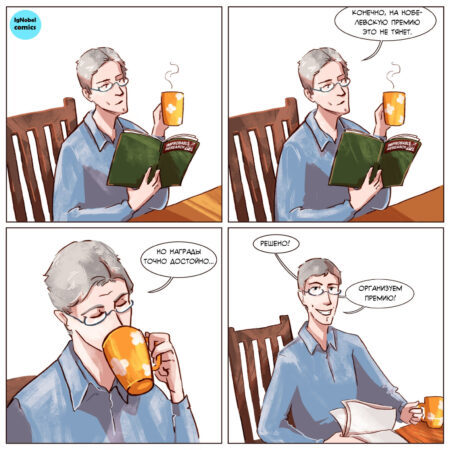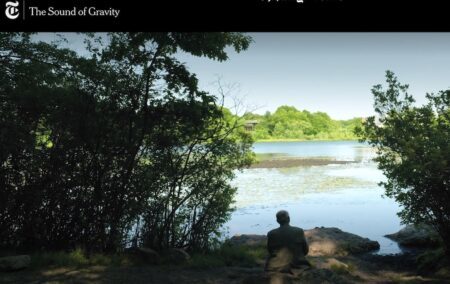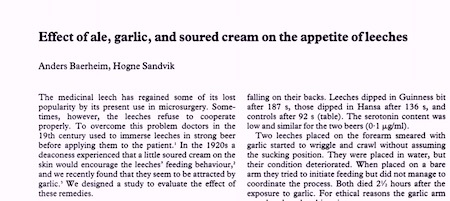Marc Abrahams's Blog, page 118
May 6, 2020
A new comic (in 2 languages) about Ig Nobel Prize winners
A new comic strip—in Russian and in English—about some of the curious characters who have won Ig Nobel Prizes. The series appears on Instagram.


Software that predicts whether you look like, and so will be, a criminal
Harrisburg University proudly announces, in a press release:
HU facial recognition software predicts criminality
A group of Harrisburg University professors and a Ph.D. student have developed automated computer facial recognition software capable of predicting whether someone is likely going to be a criminal.
With 80 percent accuracy and with no racial bias, the software can predict if someone is a criminal based solely on a picture of their face. The software is intended to help law enforcement prevent crime.
Ph.D. student and NYPD veteran Jonathan W. Korn, Prof. Nathaniel J.S. Ashby, and Prof. Roozbeh Sadeghian titled their research “A Deep Neural Network Model to Predict Criminality Using Image Processing.” …
The press release does not specify whether the three co-researchers applied the software to photographs of themselves. Here are photos of the co-researchers:



(Thanks to Michael Petrov for bringing this to our attention.)

May 5, 2020
12-Tone Music, explained without needless worship
Vi Hart, adept at mathematics, music, and explaining things, made this video that explains the point (and the lack of point, too) of 12-tone music:

Recent Progress in Automatic Sarcasm Detection
‘Sentiment mining’ – i.e. trying to gauge the Public’s attitude towards an institution, product, firm (etc. etc.) though automatic analysis of Social Media posts (etc. etc.) is now considered an essential tool for market researchers and ‘reputation managers’.
But there are problems. One of which is sarcasm. Given its prevalence, serious errors can be introduced in a Sentiment Mining Picture if it’s not reliably detected.
Work on Automatic Sarcasm Detection began in the mid 2000s – see, for example, Joseph Tepperman, David Traum, and Shrikanth S. Narayanan. “Yeah right”: Sarcasm recognition for spoken dialogue systems. In Proceedings of InterSpeech, pp. 1838–1841, Pittsburgh, PA, sep 2006.
Since then, work on refining Automatic Sarcasm Detection Algorithms has flourished. Here is a list of but-a-few of the many hundreds of scholarly works which address the issue (in no particular order).
● An Approach to Detect Sarcasm in Tweets
● Sarcasm Detection Using Feature-Variant Learning Models
● A Review Paper on Sarcasm Detection
● Sarcasm Detection with Sentiment Semantics Enhanced Multi-level Memory Network
● Sarcasm Detection Methods in Deep Learning: Literature Review
● Sarcasm Detection Using Multi-Head Attention Based Bidirectional LSTM
● Sarcasm Detection Using Deep Learning-Based Techniques
● A Multi-Dimension Question Answering Network for Sarcasm Detection
● Tweet sarcasm detection using deep neural network
● Sarcasm detection using Grice’s maxims
● Modelling Context with User Embeddings for Sarcasm Detection in Social Media’
● ‘The perfect solution for detecting sarcasm in tweets #not’
Note: One of the simplest methods, pointed out in An Approach to Detect Sarcasm in Tweets (amongst other papers above) is to look for posts or Tweets (etc. etc.) which use the hashtag #Sarcasm.
Research research by Martin Gardiner

May 4, 2020
Crazy-seeming research, now and then, turns up something true and beautiful
Crazy-seeming research, every now and then, leads to something really, really wonder-filled. In this case, the discovery of something long-predicted (by Einstein) but seemingly impossible to perceive: gravity waves. (HT Maggie Lettvin)


A reminder: How to stimulate the appetite of a medical leech
The 1996 Ig Nobel Prize for biology was awarded to Anders Barheim and Hogne Sandvik of the University of Bergen, Norway, for their tasty and tasteful report, “Effect of Ale, Garlic, and Soured Cream on the Appetite of Leeches.”
Recently, Bradley Allff, writing in Atlas Obscura, looked at the role medical leeches sometimes play in medicine in the USA. The report does not, however, look at American methods of stimulating the appetite of medical leeches that happen not to be hungry at the moment they are called to action. (Thanks to Scott Langill for bringing this to our attention.)

May 2, 2020
Pocket-Sized #1005: “Creepiness”
Creepiness
In this Pocket-Sized episode #1005, Marc Abrahams shows an unfamiliar research study to Jean Berko Gleason. Dramatic readings and reactions ensue.
The research mentioned in this episode is featured in the special Psychology issue (vol. 26, #1) of the Annals of Improbable Research magazine.

Remember, our Patreon donors, on most levels, get access to each podcast episode before it is made public.
1. Jean Berko Gleason encounters:
“On the Nature of Creepiness,” Francis T. McAndrew and Sara S. Koehnke, New Ideas in Psychology, vol. 43, December 2016, pp. 10–15.
The Wug Test, Jean Berko Gleason, Larchwood Press, 2019.
Seth Gliksman, Production Assistant
Available on Spotify, Apple Podcasts, Overcast, Google Podcasts, AntennaPod, BeyondPod and elsewhere!

May 1, 2020
Historic video of the Emergency Bra, at the Ig Nobel Prize ceremony
This video shows the awarding of the 2009 Ig Nobel Prize for medicine to Elena N. Bodnar, Raphael C. Lee, and Sandra Marijan of Chicago, Illinois, USA, for inventing a brassiere that, in an emergency, can be quickly converted into a pair of protective face masks, one for the brassiere wearer and one to be given to some needy bystander. Nobel laureates Wolfgang Ketterle, Paul Krugman, and Orhan Pamuk assisted Dr. Bodnar in giving the first public demonstration of how the bra works.

April 29, 2020
Podcast Episode #209: “Words for Food in Your Mouth”
Words for Food in Your Mouth, an Apple a Day, Eating the Shrew, an Epidemic of Penile Amputations, Reactions to Chicken Nuggets, Ig and Beyond, What Matters in NBA Games, Why Spaghetti, and What Your Gut Says Psychoanalytically.
In episode #209, Marc Abrahams shows some unfamiliar research studies to Jean Berko Gleason, Chris Cotsapas, Kishore Hari, Bruce Petschek, and Ben Lillie. Dramatic readings and reactions ensue.
Remember, our Patreon donors, on most levels, get access to each podcast episode before it is made public.
1. Jean Berko Gleason encounters:
“Texture and Chemical Feeling Descriptors That 6-11 Year Olds and Adults Associate With Food in the Mouth,” N. Oram, Journal of Texture Studies, vol. 29, no. 2, May 1998, pp. 185-97.
Szczesniak, A.S. 1972. “Consumer awareness of and attitudes to food texture: 11. Children and Teenagers,” J. Texture Studies 3, 206-217.
2. Chris Cotsapas encounters:
“Apple Consumption is Related to Better Sexual Quality of Life in Young Women,” Tommaso Cai, Mauro Gacci, Fulvio Mattivi, Nicola Mondaini, Serena Migno, Vieri Boddi, Paolo Gacci, Beatrice Detti, Paolo Gontero, Stefano Chiodini, Liliana Mereu, Saverio Tateo, Sandra Mazzoli, Gianni Malossini, and Riccardo Bartoletti, Archives of Gynecology and Obstetrics, vol. 290, February 2014, pp. 1-6.
3. Jean Berko Gleason encounters:
See the list of 2013 Ig Nobel Prize winners on the Improbable Research web site.
4. Kishore Hari encounters:
“Reaction to Chicken Nuggets in a Patient Taking an MAOI [a Monoamine oxidase inhibitor],” R. Pohl, R. Balon, and R. Berchou, American Journal of Psychiatry, vol. 145, no. 5, 1988, p. 651.
5. Bruce Petschek
“Touchscreen Performance and Knowledge Transfer in the Red-Footed Tortoise (Chelonoidis carbonaria),” Julia Mueller-Paul, Anna Wilkinson, Ulrike Aust, Michael Steurer, Geoffrey Hall, and Ludwig Huber, Behavioural Processes, vol. 106, July 2014, pp. 187–92.
“An Introduction to the Mechanics of the Lasso,” Pierre-Thomas Brun, Neil Ribe, and Basile Audoly, Proceedings of the Royal Society A, vol. 470, no. 2171, November 8, 2014.
“Chimpanzees Prefer African and Indian Music Over Silence,” Morgan E. Mingle, Timothy M. Eppley, Matthew W. Campbell, Katie Hall, Victoria Horner, and Frans B. M. de Waal, Journal of Experimental Psychology: Animal Learning and Cognition, vol. 40, no. 4, 2014, pp. 502–5.
6. Jean Berko Gleason encounters:
“Safe Leads and Lead Changes in Competitive Team Sports,” Aaron Clauset, M. Kogan, and S. Redner, arXiv:1503.03509v1, 11 Mar 2015.
7. Ben Lillie encounters:
“Localization of Breakage Points in Knotted Strings,” Piotr Pieranski, Sandor Kasas, Giovanni Dietler, Jacques Dubochet, and Andrzej Stasiak, New Journal of Physics, vol. 3, June 2001, p. 1-13.
8. Jean Berko Gleason encounters:
“New Observations on Body Organ Language,” Christian Muller, Psychotherapy and Psychosomics, vol. 42, nos. 1–4, 1984, pp. 124–6
“Borborygmi as Markers of Psychic Work During the Analytic Session: A Contribution to Freud’s Experience of Satisfaction and to Bion’s Idea About the Digestive Model for the Thinking Apparatus,” International Journal of Psycho-Analysis, vol. 71, 1990, p. 641–59.
“The Emergence of Thinking: Bion as the Link Between Freud and the Neurosciences,” Guy Da Silva, in M. Grignon (Ed.) Psychoanalysis and the Zest for Living: Reflections and Psychoanalytic Writings in Memory of W.C.M. Scott, ESF Publishers, Binghamton, NY, 1998.
“Le Modèle Alimentaire dans la Théorie de la Pensée de Bion: Suivi d’une Application de ce Modèle dans l’Analyse d’un Patient,” Guy Da Silva, Symposium of the Société Psychanalytique de Montréal, Spring 1992.
Bruce Petschek, Audio Engineer
John Shedler, Audio Engineer
Seth Gliksman, Production Assistant
Available on Spotify, Apple Podcasts, Overcast, Google Podcasts, AntennaPod, BeyondPod and elsewhere!

April 27, 2020
Towards a ‘Wrinkly Fingers’ Explanation [study]
 The mystery of wrinkly fingers may be a step closer to an explanation.
The mystery of wrinkly fingers may be a step closer to an explanation.
“Everyone has experienced wrinkly fingers after an extended exposure to water. These wrinkles have been proposed as an evolutionary mechanism for a better grip of wet objects. However, besides experimental observations or mathematical theories, there is still not a clear agreement whether this is a result of the contraction of the hypodermis ( the ‘shrink’ model), the effect of epidermal swelling (the ‘swell’ model), or the coupling of both mechanisms.”
Research teams from the Laboratori de Calcul Numeric (LaCaN), Universitat Politecnica de Catalunya, Barcelona, Spain, and the Department of Mechanical Engineering, Stanford University, US, have developed mathematical models which simulate fingertip wrinkling ‘in-silico’ (i.e. using a computer). The results suggesting that both the ‘shink’ model and the ‘swell’ model might be operating at the same time. Further work is still needed, however, to finally resolve the mystery.
“Without doubt, further experiments will help to close the debate about the origin of fingertip wrinkling.”
See: Mechanics reveals the biological trigger in wrinkly fingers P Sáez, AM Zöllner – Annals of Biomedical Engineering, 2017
Also see: Fingers-only glove [new patent]
Research research by Martin Gardiner

Marc Abrahams's Blog
- Marc Abrahams's profile
- 14 followers





